Frequently Asked Questions About Orthodontics
Orthodontics (also referred to as dentofacial orthopedics) is a specialization in dentistry that focuses on the diagnosis, prevention, and treatment of dental and facial abnormalities.
An orthodontist is a dental specialist who has undergone two to three years of additional training and experience. Your orthodontist is able to straighten teeth, correct misaligned jaw structure, and improve the function of your smile.
If you want to improve the look and feel of your smile, then any age can be a great age to see the orthodontist. The American Association of Orthodontists recommends that children first visit an orthodontist around the age of seven. However, orthodontic treatment is not exclusive to children and teens, with about one in every five orthodontic patients being over the age of 21. Whether you're considering treatment for yourself or for a child, any time is a good time to visit the orthodontist.
- ALWAYS remember to brush your teeth after every meal and floss at least once a day.
- Make sure to use toothpaste that contains fluoride and ask your orthodontist or family dentist if you need a fluoride rinse. This will help prevent cavities!
- If you take out your retainer to eat, make sure you brush your teeth, floss, and remember to keep your retainer safe in its container so that it does not get lost or broken.
- Keep your retainer clean, too, by brushing it gently with a toothbrush and toothpaste. You may also soak it in denture cleaner as instructed by your orthodontist. Do not put your retainer in boiling water or in the dishwasher.
- During your treatment, try to avoid foods with a lot of sugar, which increases the number of bacteria that grows in your mouth, causing more plaque and possibly cavities.
- Avoid sticky and chewy foods (caramel, chewing gum, gummy bears), hard foods (hard candy, nuts, ice cubes), or any foods that could possibly get stuck in your braces (corn on the cob, soft bagels, ribs, taffy, etc.).
- Be sure to schedule your routine checkups with your family dentist. It is recommended that you continue to visit the dentist every six months.
Braces are used by your orthodontist to help you improve the look and feel of your smile. There are several different types of braces to choose from, including:
- Clear braces
- Ceramic braces
- Lingual braces
- Self-ligating braces
- Invisible braces
- Traditional metal braces
The amount of time spent in braces will vary depending on the individual patient, because every smile responds differently to treatment. Treatment times can take anywhere between six and 30 months, but most standard treatments take about 22 months.
Braces do not often hurt though you may feel a small amount of discomfort for a couple days as your teeth, gums, cheeks, and mouth get used to your new braces.
With braces, you should brush your teeth at least three times a day to keep your teeth, gums, and mouth healthy and clean. Brushing regularly will help remove any food that may be caught between the braces. You should also floss daily to clean between your braces where your brush isn't able to reach. Your orthodontist can show you how to properly brush and floss once your braces are placed.
Yes! In fact, it's even more important that patients receiving orthodontic treatment visit their dentist regularly. With braces, food may be caught in places that your toothbrush can't reach. This causes bacteria to build up that can lead to cavities, gingivitis, and gum disease. Your dentist will work closely with your orthodontist to make sure that your teeth stay clean and healthy while wearing braces.
Playing an instrument or a contact sport may require some adjustment when you first get your braces, but wearing braces will not stop you from participating in any of your school activities. If you play a contact sport, it is recommended that you wear a mouthguard to protect your braces or appliance.
Simply call our practice! Our front desk staff will be happy to help schedule your next appointment at your convenience. If you are a new patient or have been referred to our practice, please let us know and we will provide you with all of the information you need.
When it comes to straightening your teeth discreetly, clear aligners are a popular choice. Here is a step-by-step process to insert them:
- First, make sure your hands are clean and dry. This will prevent any bacteria from transferring onto the aligners or into your mouth.
- Next, locate the tray that corresponds to either your upper or lower teeth. Hold the tray using two hands and gently place it over your teeth, starting from one side and working towards the other. Use light pressure with your fingertips to ensure a snug fit. Don't worry if there's some resistance initially; this is normal, as the aligner needs time to adjust.
- Once in position, use your index fingers to push down on each tooth until you feel a slight click or snap. This indicates that the aligner is securely seated against your teeth.
Remember to wear each set of aligners for 20 to 22 hours per day as prescribed by your orthodontist. Only remove them when eating, drinking (except water), brushing, and flossing.
Once you have completed the recommended duration for wearing your clear aligners, it's time to remove them. Removing clear aligners can be a simple and straightforward process if done correctly. Here are some steps to help you safely and easily remove your clear aligners:
- Start by locating the edges of the aligner: Gently use your finger or fingernail to find where the edge of the aligner meets your teeth.
- Use downward pressure: Apply slight downward pressure with your fingertips on both sides of one tooth until you feel the aligner start to loosen.
- Wiggle gently: Once you feel a bit of give in that area, wiggle the aligner back and forth while keeping upward pressure on that same tooth.
- Gradually work around each tooth: Repeat this process for each tooth, moving from one side of your mouth to the other until all teeth are free from the aligner.
- Be patient and gentle: Take care not to rush or force removal, as this can cause discomfort or potential damage to both your teeth and the clear aligners themselves.
Remember, always follow any specific instructions provided by our orthodontist when removing clear aligners, as every case may differ slightly in terms of technique or additional tips they recommend for easy removal.
Here's a step-by-step guide to help you through the process:
- Make sure your hands are clean and dry before handling your retainer. This will help prevent any bacteria or dirt from transferring onto the appliance.
- Next, gently place the retainer on your tongue and use your fingers to guide it into position against the roof of your mouth. Make sure that it is comfortably resting over your teeth.
- Once in position, use light pressure with your fingers to press down evenly on all areas of the retainer. This will ensure that it fits snugly against your teeth and stays securely in place.
- Take some time to get used to wearing the retainer by speaking slowly and practicing different sounds or words. It may feel strange initially, but this adjustment period is normal.
Remember to wear your retainer as instructed by our orthodontist — whether during specific times of the day or overnight — as consistent usage is key for effective results.
Removing a retainer can sometimes be a bit tricky, but with the right technique and some patience, it can become an easy part of your daily routine. Here are some tips to help you effectively remove your retainer:
- Wash your hands: Before attempting to remove your retainer, make sure your hands are clean. This will minimize the risk of transferring any bacteria or dirt onto the retainer.
- Use gentle pressure: When removing your retainer, apply gentle pressure using both hands. Avoid pulling or tugging too hard, as this could damage the appliance.
- Start from one side: Begin by gently lifting one side of the retainer away from your teeth using your fingers or a special tool provided by your orthodontist. Slowly work around each tooth until the entire device is released.
- Be patient: It's important to take your time when removing a retainer, especially if it fits tightly over certain teeth. Rushing could lead to discomfort or even breakage.
- Clean properly after removal: Once you have successfully removed your retainer, rinse it thoroughly with water and use a soft toothbrush to clean it gently before storing it in its case.
With time and experience, you'll find that this process becomes easier and more effortless.
Losing or breaking orthodontic appliances can be a hassle, but it's important that you do not panic. There are steps you can take to address the situation and ensure that your treatment continues smoothly.
- Contact your orthodontist as soon as possible. They will provide guidance on what needs to be done, whether it's scheduling an appointment for repairs or providing temporary solutions until you can get in to see them.
- If a wire or bracket is causing discomfort or poking into your gums, try using wax provided by your orthodontist to alleviate the pain temporarily. Applying a small piece of wax over the bothersome area should help protect your mouth from further irritation.
- In some cases, if a removable appliance like aligners gets lost or damaged beyond repair, it may need to be replaced entirely. In such instances, reach out to our orthodontist immediately so they can assess the situation and determine the best course of action.
Remember that accidents happen sometimes, and it's crucial that you do not delay seeking professional advice when faced with broken or missing appliances during orthodontic treatment. By taking prompt action and following recommendations from your orthodontist, you'll ensure that any setbacks are resolved efficiently without compromising progress toward achieving a beautiful smile.
Crowding of the teeth
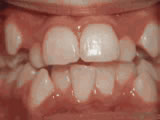 Before
Before
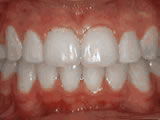 After
After
Patient started treatment at age 11 and wore braces for 26 months. He loves his new smile.
Open bite - Front teeth don't touch
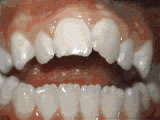 Before
Before
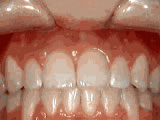 After
After
Patient sucked her thumb as a young child. She started treatment at age 13. She had braces and a special appliance — called a crib — to retrain the tongue, for 28 months. Now she can bite the lettuce out of a sandwich.
Deep overbite - Lower front teeth bite into palate
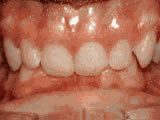 Before
Before
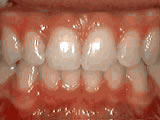 After
After
This adult patient, age 25, required braces and jaw surgery to correct his severe overbite, with treatment taking two years. His problem could have been corrected without surgery if he had been treated before he was a teenager.
Missing lateral incisors
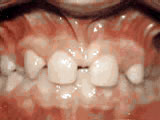 Before
Before
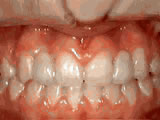 After
After
This patient's lateral incisors were congenitally missing. She had braces for 20 months to move the teeth into their correct positions, then the missing teeth were replaced with bonded "Maryland" bridges.
Underbite - Lower front teeth in front of upper teeth
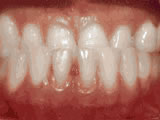 Before
Before
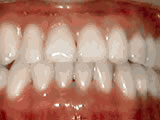 After
After
Patient's underbite was causing her jaw joint discomfort and excessive wear patterns on her teeth. After about 30 months of treatment starting at age 32, she now finds smiling and chewing much easier.
Spacing of teeth
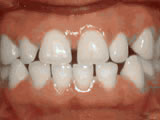 Before
Before
 After
After
Patient was bothered by the spaces between his teeth. Braces closed the spaces and gave him an ideal bite in 24 months. Special glued-in retainers help keep the spaces closed.
Overjet - Protruding front teeth
 Before
Before
 After
After
At age ten, patient had a big overjet with the top teeth protruding beyond the bottom. She had two phases of treatment. The first helped her jaws to grow more harmoniously and the second aligned her teeth and bite. At age 13, she was proudly displaying her new smile.
Non-braces treatment
 Before
Before
 After
After
Sometimes braces are not needed to get noticeable improvements in tooth alignment. This patient was first seen at age seven for crowding of the lower permanent teeth. A procedure was performed to reduce the width of the adjacent baby teeth and the permanent incisors aligned on their own in nine months.
Phase-One
 Before
Before
 After
After
Patient's parents were concerned about both aesthetics and the health of the erupting permanent teeth when they brought him to the orthodontist at age eight. The lower front teeth were crowded and touching the palate, and the upper front teeth were extremely displaced from their normal positions. After 12 months of Phase-One treatment with an expander and partial braces, patient's appearance and dental function were vastly improved.
Locations
- MON - THU9:00 am - 5:00 pm
- FRIClosed
- SAT8:45 am - 1:00 pm
- SUNClosed
- MON - THU9:00 am - 5:00 pm
- FRIClosed
- SAT8:45 am - 1:00 pm
- SUNClosed
